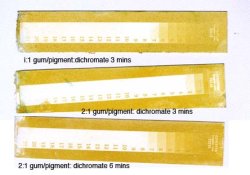phritz phantom
Member
- Joined
- Aug 20, 2006
- Messages
- 211
- Format
- Medium Format
i'm on my first foray into gum printing, using the fotospeed kit.
has anybody ever used this kit? and has any tips or bewares for using it?
one thing i'm wondering is that there's not a single word on the dangers of gum printing. it's not even mentioned which chemicals are in the solutions.
so, the sizing should be some kind of gelatine- harmless (although smells horrible). so is the gum arabic.
the sensitizer is potassium or ammonium dichromate - the dangerous stuff.
but what's in the clearing solution?
and the exposure?
the fotospeed manual says: up to 24minutes for sunlight; bill mabrey says: 6-7minutes in sunlight.
and does it have to in direct sunlight or is normal daylight sufficient (not in the shadows of course)?
if i coat the paper today (at night) and plan to do the exposure tomorrow afternoon, is it safe to store the dried, coated paper? say, in a bag which comes with photographic paper?
and how to store the developed gum prints? is all the bichromate gone after development (the water bath)?? or are there still traces of the chemical in the emulsion?
i somehow don't trust those images...
has anybody ever used this kit? and has any tips or bewares for using it?
one thing i'm wondering is that there's not a single word on the dangers of gum printing. it's not even mentioned which chemicals are in the solutions.
so, the sizing should be some kind of gelatine- harmless (although smells horrible). so is the gum arabic.
the sensitizer is potassium or ammonium dichromate - the dangerous stuff.
but what's in the clearing solution?
and the exposure?
the fotospeed manual says: up to 24minutes for sunlight; bill mabrey says: 6-7minutes in sunlight.
and does it have to in direct sunlight or is normal daylight sufficient (not in the shadows of course)?
if i coat the paper today (at night) and plan to do the exposure tomorrow afternoon, is it safe to store the dried, coated paper? say, in a bag which comes with photographic paper?
and how to store the developed gum prints? is all the bichromate gone after development (the water bath)?? or are there still traces of the chemical in the emulsion?
i somehow don't trust those images...
Last edited by a moderator:












